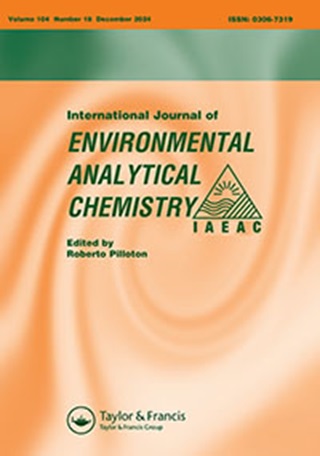通过合成甘蔗渣磁性氧化石墨烯,在可见光照射下光催化去除水溶液中的 AR14
IF 2.5
4区 化学
Q3 CHEMISTRY, ANALYTICAL
International Journal of Environmental Analytical Chemistry
Pub Date : 2023-12-29
DOI:10.1080/03067319.2021.2009473
引用次数: 0
摘要
摘要 本研究分几个阶段合成了甘蔗渣磁性氧化石墨烯(SCBMGO),并将其用于在 LED 可见光下去除酸性红 14 染料。XRD、FT-IR、SEM、EDX、VSM 和 pHPZC 分析表明了其结构特征。研究了 pH 值、催化剂剂量、染料浓度、过氧化氢、净化气体、有机化合物、离子强度等变量对 AR14 去除效率的影响,以及不同工艺、自由基清除剂和可重复使用性的比较。在理想情况下,去除效率最高:[AR14]0 = 10 mgL-1,SCBMGO 用量 = 0.5 gL-1,pH = 3,过氧化氢 = 5 mM,接触时间等于 120 分钟。除剂量外,光催化去除 AR14 的效率随其他变量的增加而降低。AR14 的光催化去除服从假二阶反应动力学。LED/SCBMGO 工艺的 EEO 值(59.62 kWh/m3)是去除率的函数,表明该工艺提高了生产率,降低了系统消耗的电能成本。LED/SCBMGO 工艺对 AR14 的去除效率最高(89.85%)。此外,开始阶段和第六阶段的回收测试效率相同。饮用水中 AR14 的去除率为 71.45%。SCBMGO作为一种有效且环保的催化剂,可用于在LED可见光下去除水环境中的AR14染料和有机污染物。本文章由计算机程序翻译,如有差异,请以英文原文为准。
Photocatalytic removal of AR14 from aqueous solutions under visible light irradiation by synthesising sugarcane bagasse magnetic graphene oxide
ABSTRACT At this present investigation, sugarcane bagasse magnetic graphene oxide (SCBMGO) was synthesised in several stages and used to remove Acid Red 14 dye under LED visible light. XRD, FT-IR, SEM, EDX, VSM and pHPZC analyses demonstrated the structural characteristics. The effect of variables like the pH, catalyst dose, dye concentration, hydrogen peroxide, purging gases, organic compounds, ionic strength, and comparison of different processes, radical scavengers, and reusability on AR14 removal efficiency were investigated. The most removal efficiency occurred under ideal situation: [AR14]0 = 10 mgL−1, SCBMGO dosage = 0.5 gL−1, pH = 3, hydrogen peroxide = 5 mM, and contact time equal to 120 minutes. Except for the dose, the efficiency of photocatalytic removal of AR14 decreased with the addition of other variables. AR14 photocatalytic removal obeyed the pseudo-second-order reaction kinetic. The EEO value for LED/SCBMGO (59.62 kWh/m3) process, as a function of removal proficiency, illustrated that this process was elevated productivity and diminished the cost of electrical energy consumed by the system. The highest removal efficiency of AR14 occurred in the LED/SCBMGO process (89.85%). In addition, recycling test efficiency was the same at the beginning, and the 6th stage. The removal efficiency of AR14 in drinking water was (71.45%). SCBMGO, as an effective and environmentally friendly catalyst, can be used in removing AR14 dye and organic pollutants of aqueous environments under the LED visible light.
求助全文
通过发布文献求助,成功后即可免费获取论文全文。
去求助
来源期刊
CiteScore
5.90
自引率
7.70%
发文量
373
审稿时长
4.4 months
期刊介绍:
International Journal of Environmental Analytical Chemistry comprises original research on all aspects of analytical work related to environmental problems. This includes analysis of organic, inorganic and radioactive pollutants in air, water, sediments and biota; and determination of harmful substances, including analytical methods for the investigation of chemical or metabolic breakdown patterns in the environment and in biological samples.
The journal also covers the development of new analytical methods or improvement of existing ones useful for the control and investigation of pollutants or trace amounts of naturally occurring active chemicals in all environmental compartments. Development, modification and automation of instruments and techniques with potential in environment sciences are also part of the journal.
Case studies are also considered, particularly for areas where information is scarce or lacking, providing that reported data is significant and representative, either spatially or temporally, and quality assured. Owing to the interdisciplinary nature of this journal, it will also include topics of interest to researchers in the fields of medical science (health sciences), toxicology, forensic sciences, oceanography, food sciences, biological sciences and other fields that, in one way or another, contribute to the knowledge of our environment and have to make use of analytical chemistry for this purpose.

 求助内容:
求助内容: 应助结果提醒方式:
应助结果提醒方式:


